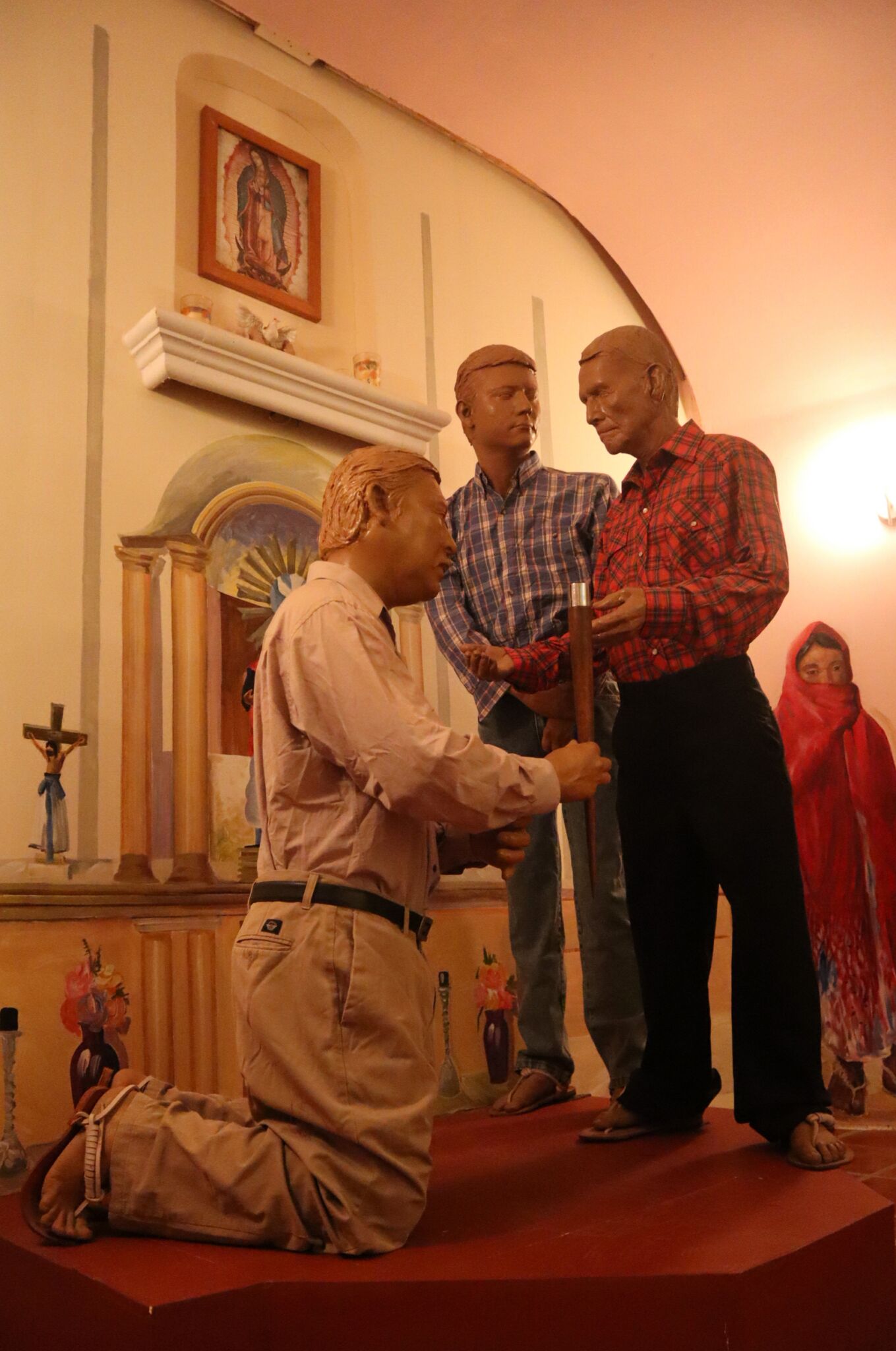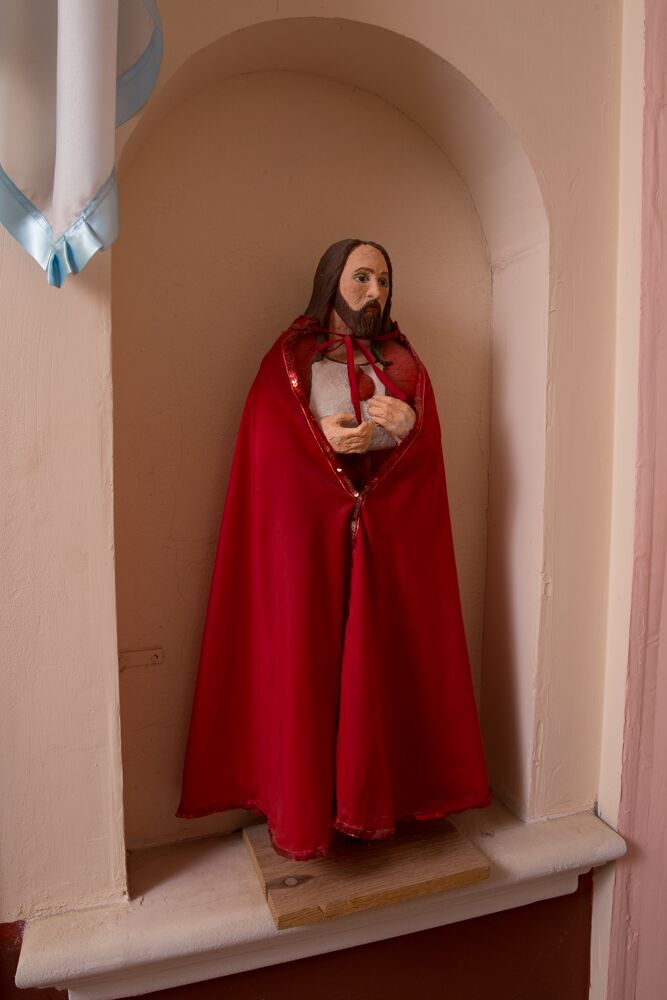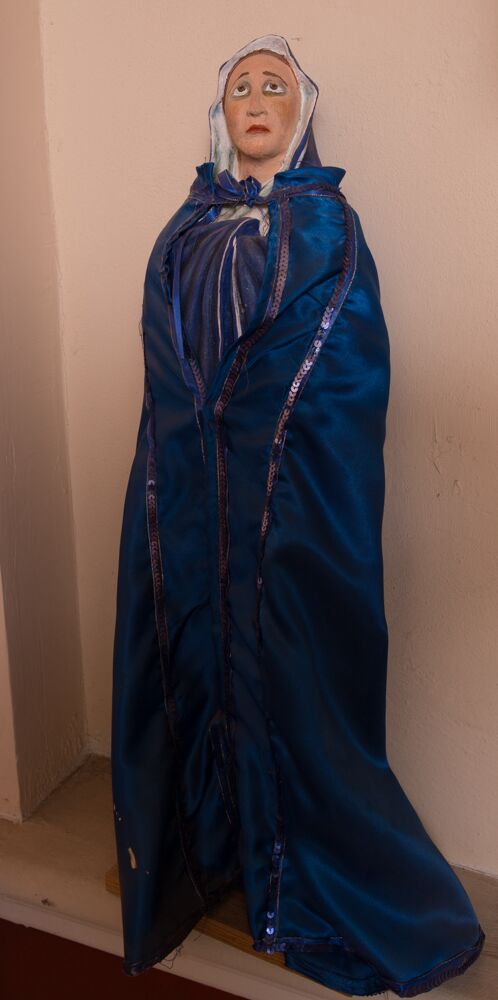-
 Danzante de CoyoteDownload
Danzante de CoyoteDownload
Full body male figure; fully represents the clothing of the Coyote dancer. Its origin dates back to the pre-Hispanic era, where characters transformed into coyotes, raccoons, etc. were used to worship natural deities such as the Sun and the Moon. This is precisely where the coyote dance arises, as a worship of the Sun God, and the reason for being of all animals in their coexistence with humans. They chose the coyote to represent them in the war, because he is intelligent, cunning, shrewd, and had all the characteristics to survive the desert. The Coyote dance is exclusive to men and is known as go'i yaut (Yaqui chief); For its part, the plume is known as go'i jiisa and/or go'i choomo, which represents the halo of the Virgin of Guadalupe, the feathers that adorn it are of an aguililla, falcon, quelele, roadrunner, among others. Wearing the plume with all the feathers concentrates for the dancer all the skills of each of the natural elements that compose it (Mesri and Carlón, 2019). At the front, he wears a mother-of-pearl shell to represent the bawe ania (universe of the sea). In his hand he carries the kuta wikoi (bow) and in his quiver he carries the baka ju'i wa (reed arrows). The Coyote dance is performed on very special occasions for the Yaqui people. It is considered one of the oldest of the tribe, since remote times, it has been executed by the Yaqui militia, respected for its eminently warrior activity; his songs about the challenges of the warrior towards death and his perpetual mission of safeguarding and protecting the Toosa. The coyote dance is danced when someone is a mujteko (consecrated) in a military position. The person is consecrated in the church, later they are taken to the traditional guard where they are made to dance Coyote. As part of the initiation to the dance, the godfather of consecration, a wiko yaut (Yaqui chief) will stand in the center, to the left of him will be the new consecrated (godson), and to the right of him a coyote warrior. It is also carried out when a member of the Wiko ya'ura Order (Yaqui militia) dies, as well as governors, older people and Basario people.
Metadata
Title
Coyote dancer
Creator
Hernández Correa, Julio
Created
2008
Type
Description
Objects: 1 light sculpture in cardboard technique and metallic internal structure; 1 coyote headdress with quelele feathers; 1 white handkerchief; 1 shirt; 1 belt; 1 pants; 1 bow; 1 alijaba; 2 arrows; 2 sandals.
Description
Full body male figure; fully represents the clothing of the Coyote dancer. Its origin dates back to the pre-Hispanic era, where characters transformed into coyotes, raccoons, etc. were used to worship natural deities such as the Sun and the Moon. This is precisely where the coyote dance arises, as a worship of the Sun God, and the reason for being of all animals in their coexistence with humans.
They chose the coyote to represent them in the war, because he is intelligent, cunning, shrewd, and had all the characteristics to survive the desert. The Coyote dance is exclusive to men and is known as go'i yaut (Yaqui chief); For its part, the plume is known as go'i jiisa and/or go'i choomo, which represents the halo of the Virgin of Guadalupe, the feathers that adorn it are of an aguililla, falcon, quelele, roadrunner, among others. Wearing the plume with all the feathers concentrates for the dancer all the skills of each of the natural elements that compose it (Mesri and Carlón, 2019).
At the front, he wears a mother-of-pearl shell to represent the bawe ania (universe of the sea). In his hand he carries the kuta wikoi (bow) and in his quiver he carries the baka ju'i wa (reed arrows). The Coyote dance is performed on very special occasions for the Yaqui people. It is considered one of the oldest of the tribe, since remote times, it has been executed by the Yaqui militia, respected for its eminently warrior activity; his songs about the challenges of the warrior towards death and his perpetual mission of safeguarding and protecting the Toosa.
The coyote dance is danced when someone is a mujteko (consecrated) in a military position. The person is consecrated in the church, later they are taken to the traditional guard where they are made to dance Coyote. As part of the initiation to the dance, the godfather of consecration, a wiko yaut (Yaqui chief) will stand in the center, to the left of him will be the new consecrated (godson), and to the right of him a coyote warrior. It is also carried out when a member of the Wiko ya'ura Order (Yaqui militia) dies, as well as governors, older people and Basario people.
Format
Still image / jpg
Spatial
Sonora , Cócorit
Temporal
2001 - 2010
Is part of
Music and dance room, Museum of the Yaqui people
Provenance
Museum of the Yaqui people. Sinaloa and Obregon No. 200, Cocorit, Cajeme, Sonora
Acquired for the reopening of the museum in the town of Cócorit. It is exhibited in the traditional festival room of the Museum.
Language
eng , yaqui
Date
2022-03-01
Identifier
WEB CATALOGACION OBREGON 2016-2524 | RS-OM-MEY-71
Relationship
Drum | Arrows | Bow | Yaqui flag | Annual fiesta calendar | Coyote dancer video | Yaqui governor | Yaqui soldier oath | Quiver
References
Mesri Hashemi-Dilmaghani, Parastoo A.; Carlón Flores, María A. (2019). La organización político-social de la tribu yoeme (yaqui). México: Tribunal Electoral del Poder Judicial de la Federación.
Contributor
Sonoran Institute of Culture
Rojas Vega, Olavo (photography)
Buitimea Flores, Teodoro; Ruiz Félix, José María (investigation)
Valencia, Carlos ; The Yaqui Pride Project (translation to english)
License

This work is licensed under a Creative Commons Attribution-NonCommercial-ShareAlike 4.0 International License.
Rights
Sonoran Institute of Culture



